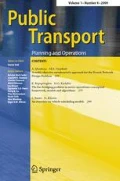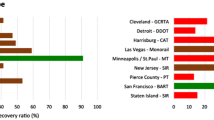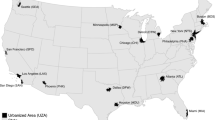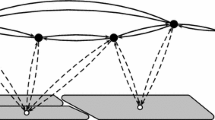Abstract
This paper investigates how the local authorities could efficiently regulate the public transit, which is operated by a private firm. Both the waiting time at stops and the in-vehicle congestion costs are taken into account to reflect the transit service quality. The Pareto-efficient frontier is derived and three types of regulation strategies, namely Price-cap, Return-on-output and Quantity control, are analyzed and compared. On one hand, although the Price-cap regulation can attract more demand effectively, the private firm will inefficiently supply a lower frequency to keep the cost down. On the other hand, both the Return-on-output (ROO) and Quantity-control regulations are Pareto efficient that can keep the transit system operating along the Pareto-efficient frontier. Especially, Quantity-control regulation seems to be more attractive than ROO as there is no need for the firm’s accounting information. In addition to the investigations on regulation, a new optimal demand-frequency correspondence is also derived that extends the Mohring’s “Square Root Principle” in incorporating transit in-vehicle congestion effects.


Similar content being viewed by others
References
Ahn K (2009) Road pricing and bus service policies. J Transp Econ Policy 43:25–53
Andersen B (1992) Factors affecting European privatisation and deregulation policies in local public transport: the evidence from Scandinavia. Transp Res, Part A, Policy Pract 26:179–191
Basso L, Jara-Díaz S (2010) The case for subsidization of urban public transport and the Mohring effect. J Transp Econ Policy 44:365–372
Glaeser EL, Shleifer A (2001) A reason for quantity regulation. Am Econ Rev 91:431–435
Glaister S (1979) On the estimation of disaggregate welfare losses with an application to price distortions in urban transport. Am Econ Rev 69:739–746
Grasman SE, Faulin J, Lera-Lopez F (2008) Public-private partnerships for technology growth in the public sector. In: IEMC—Europe 2008: international engineering management conference proceedings, pp 241–244
Guo X, Yang H (2010) Pareto-improving congestion pricing and revenue refunding with fixed demand. Transp Res, Part B, Methodol 44(8–9):972–982
Hamdouch Y, Lawphongpanich S (2008) Schedule-based transit assignment model with travel strategies and capacity constraints. Transp Res, Part B, Methodol 42:663–684
Huang HJ, Tian Q, Yang H, Gao ZY (2004) Modeling the equilibrium bus riding behavior in morning rush hour. In: Proceedings of the 9th annual conference of the Hong Kong society of transportation studies, Hong Kong, pp 434–442
Jansson JO (1980) A simple bus line model for optimization of service frequency and bus size. J Transp Econ Policy 14:53–80
Jorgensen F, Pedersen PA (2004) Travel distance and optimal transport policy. Transp Res, Part B, Methodol 38:415–430
Jorgensen F, Preston J (2007) The relationship between fare and travel distance. J Transp Econ Policy 41:451–468
Karamychev VA, Van Reeven P (2009) A monopolist in public transport. Tinbergen Institute, Discussion Paper TI 2009-77/1
Lam WHK, Morrall J (1982) Bus passenger walking distances and waiting times: a summer-winter comparison. Transp Q 36:407–421
Lam WHK, Cheung CY, Lam CF (1999) A study of crowding effects at the Hong Kong light rail transit stations. Transp Res, Part A, Policy Pract 33:401–415
Maskin E, Tirole J (2008) Public–private partnerships and government spending limits. Int J Ind Organ 26:412–420
Miettinen KM (1999) Nonlinear multiobjective optimization. Kluwer Academic, Boston
Mohring H (1972) Optimization and scale economies in urban bus transportation. Am Econ Rev 62:591–604
Mohring H (1976) Transportation economics. Ballinger, Cambridge
Mohring H, Schroeter J, Wiboonchutikula P (1987) The values of waiting time, travel time, and a seat on a bus. Rand J Econ 18:40–56
Pedersen PA (1994) Regulating a transport company with private information about costs. J Transp Econ Policy 28:307–318
Pedersen PA (1995) Public regulation of a transport company with private information about demand. J Transp Econ Policy 29:247–251
Pedersen PA (2003) On the optimal fare policies in urban transportation. Transp Res, Part B, Methodol 37:423–435
Savage I, Small K (2010) A comment on “Subsidization of urban public transport and the Mohring effect”. J Transp Econ Policy 44:373–380
Tan ZJ, Yang H, Guo XL (2010) Properties of Pareto efficient contracts and regulations for road franchising. Transp Res, Part B, Methodol 44:415–433
Tian Q, Huang HJ, Yang H (2007) Equilibrium properties of the morning peak-period commuting in a many-to-one mass transit system. Transp Res, Part B, Methodol 41:616–631
Tian Q, Huang HJ, Lam WHK (2009) How do transit commuters make trade-off between schedule delay penalty and congestion cost: an empirical study in Beijing. Transp Res Rec 2134:164–170
Van Reeven P (2008) Subsidization of urban public transport and the Mohring effect. J Transp Econ Policy 42:349–359
Vickrey WS (1955) Some implications of marginal cost pricing for public utilities. Am Econ Rev 45:605–620
Vuchic VR (2005) Urban transit: operations, planning and economics. Wiley, New York
Acknowledgements
The authors would like to thank two anonymous reviewers and the conference participants at CASPT 2009 (Hong Kong) for their helpful comments. The work described in this paper was supported by the joint research scheme between the National Natural Science Foundation of China (70801002, 70931160447, 71071011) and the Research Grant Council of the Hong Kong Special Administrative Region (N_HKUST607/09) and a project from the Fundamental Research Funds for the Central Universities (YWF-10-01-A26).
Author information
Authors and Affiliations
Corresponding author
Rights and permissions
About this article
Cite this article
Tian, Q., Yang, H. & Huang, HJ. Pareto efficient strategies for regulating public transit operations. Public Transp 3, 199–212 (2012). https://doi.org/10.1007/s12469-011-0047-8
Published:
Issue Date:
DOI: https://doi.org/10.1007/s12469-011-0047-8




